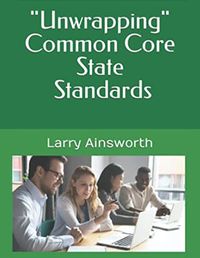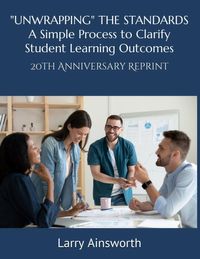TIMELESS PRACTICES TO IMPROVE STUDENT LEARNING
Supporting educators and leaders in their important work of helping every student become a confident and successful learner
"Unwrapping" Common Core State Standards And "Unwrapping" the Standards
TIMELESS PRACTICE #2
DESCRIPTION OF BOOKS:
"Unwrapping" the standards is a simple but powerful practice to help educators clarify what students must know and be able to do. When educators take the time to analyze each standard and identify its essential concepts and skills, the result is more effective instructional planning, higher quality assessment design, and improved student learning.
In 2003, I wrote “Unwrapping” the Standards: A Simple Process to Make Standards Manageable. In 2023, I republished the original book as a 20th Anniversary Reprint, entitled, "Unwrapping" the Standards: A Simple Process to Clarify Student Learning Outcomes. Sharing the stories of K-12 educators and leaders across the country who have successfully implemented this process, the text convincingly explains why “unwrapping” standards continues to be a "timeless" practice to elevate teaching and learning.
Key features of this 20th Anniversary Reprint include how to:
• Clarify specific concepts and skills students need to know and be able to do from the wording of the standards
• Represent the “unwrapped” concepts and skills on a graphic organizer of choice
• Determine Big Ideas (the “aha’s” or “lightbulb” moments of understanding) teachers want students to discover as they learn the “unwrapped” standards
• Write Essential Questions that actively engage students and promote their own discovery of the Big Ideas.
• Increase understanding of the complete process with over 80 examples of “unwrapped” standards across the four grade spans (K-2, 3-5, 6-8, and 9-12) in multiple content areas.
Plus, a time-saving feature! Ready-to-use checklists and templates to help educators immediately apply this simple, proven technique for managing the standards!
****************************************************************
In 2013, I applied the same effective process to “Unwrapping” the Common Core: A Practical Process to Manage Rigorous Standards, which I republished in 2022 as “Unwrapping” Common Core State Standards. Based on my years of experience presenting “Unwrapping” workshops across the country, the book provides a detailed, how-to guide for busy K-12 educators and shows how to assign levels of rigor to each of the “unwrapped” concepts and skills. Applicable to all standards, not to the Common Core only, it’s organized in an easy-to-read format that includes 60 ELA and math examples across the four grades spans (K-2, 3-5, 6-8, and 9-12) that illustrate each of the four dynamic steps in the process.
PROCESS:
OVERVIEW OF THE FOUR-STEP PROCESS – HOW TO “UNWRAP”
1. “Unwrap” the Unit Priority Standards. Analyze and deconstruct the Priority Standards to be taught in a unit of study in order to determine the specific, teachable concepts and skills that students need to know and be able to do.
2. Create a Graphic Organizer. Choose a graphic organizer format (outline, bulleted list, concept map, or chart) to visually display the “unwrapped” skills and their related concepts. Determine the approximate level of rigor for each skill-concept pair, using the Revised Bloom’s Taxonomy and/or Webb’s Depth of Knowledge.
3. Decide the Big Ideas. Referring to the “unwrapped” concepts, decide the Big Ideas (key understandings, “aha’s”) you want students to discover and be able to state in their own words by the end of the unit of study.
4. Write the Essential Questions. Referring to the Big Ideas, write creative, open-ended Essential Questions that will engage students throughout the unit and lead them to discover the Big Ideas for themselves.
Even though the entire “unwrapping” process was developed in response to the need for a more effective way to manage the standards, essentially this is just about good teaching. PK-12 educators have enthusiastically endorsed this technique as a powerful way to clarify the meaning and components of all Power (Priority) Standards in any and all content areas.
In both books, Priority Standards and Prioritizing Common Core State Standards, the connections to each of the four main process steps include:
- Deciding what is important for students to learn in a particular content area (“unwrapping”)
- Helping students make connections to other areas of study and utilize higher-level thinking skills (Big Ideas), and
- Engaging students in the material to be studied by setting a purpose for learning (Essential Questions).
Even if your standards change in the future, the technique of “unwrapping” will always remain relevant and current. You will be able to effectively use and reuse this "timeless" practice to positively impact the quality of your teaching and the corresponding learning of your students!
Larry Talks About “Unwrapping” the Standards
Praise for “Unwrapping” the Standards Book:
“With his process of ‘Unwrapping” the Standards, Larry made planning and implementing lessons so engaging that administrators wanted to go back to the classroom…Larry is down-to-earth, funny, practical, knowledgeable, and he really listens to teachers’ needs. If you can’t manage to get Larry Ainsworth to your school district, the next best thing is to read his books!” –Meg Sanchez, Lennox School District, California
“Unwrapping” the Standards brought our state standards to life. Our teachers are thrilled with the discoveries they have made through this process…our students understand what the learning expectations actually are.” Karen Gould, Metropolitan School District of Wayne Township, Indiana
“As my staff began to ‘unwrap’ our standards, we began to see exactly what should be taught as well as what we were missing. ‘Unwrapping” the Standards has resulted in improved scores—and a deeper understanding of our students.” Deb Mansfield, Norfolk Public Schools, Virginia
“After Larry conducted an all-day ‘Unwrapping’ the Standards workshop for our New York City administrators and staff developers, the sentiments were genuine. Participants said, ‘Now the standards make sense…we know what we have to do when we return to our schools.’ We wished we could have had him for a longer period of time!” Sandra Herndon, New York State Education Department






